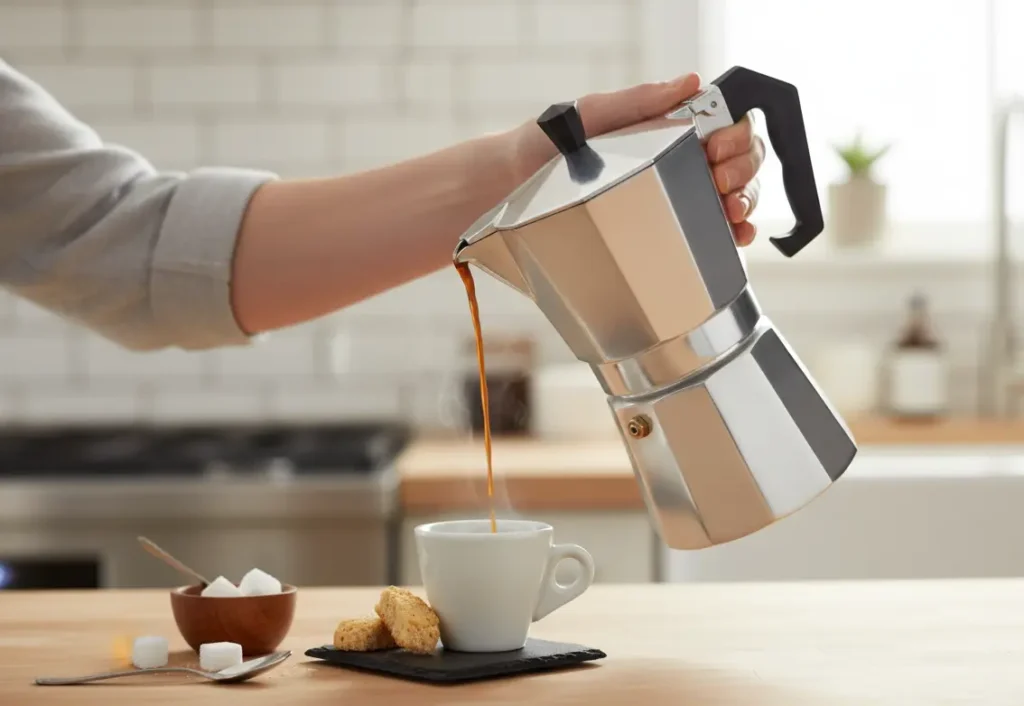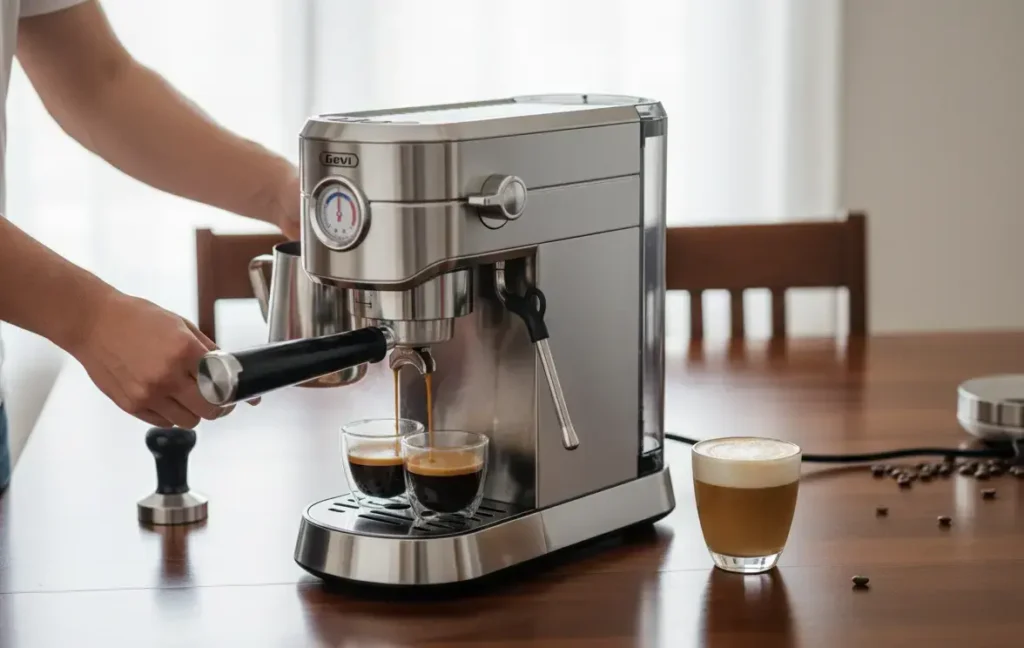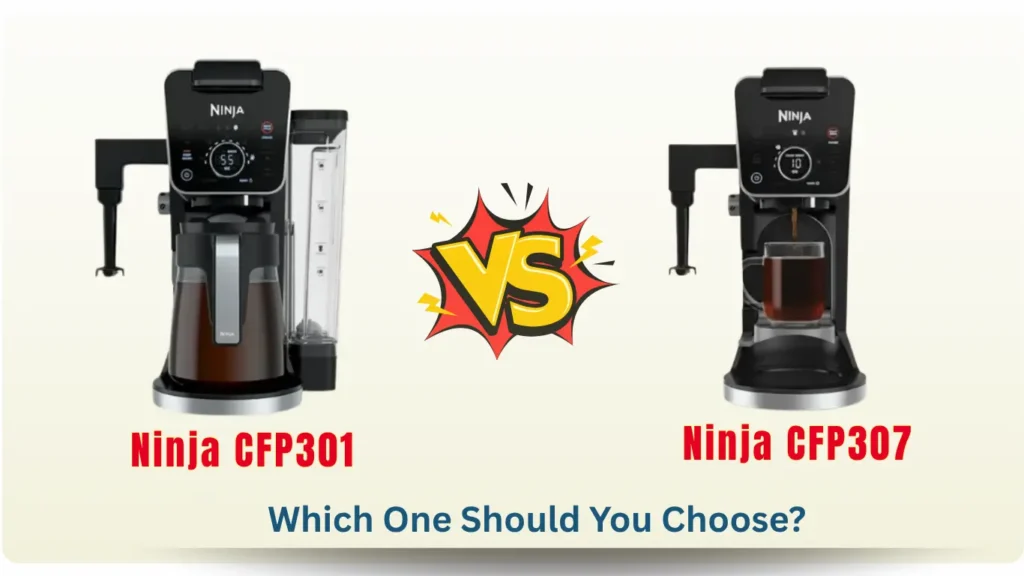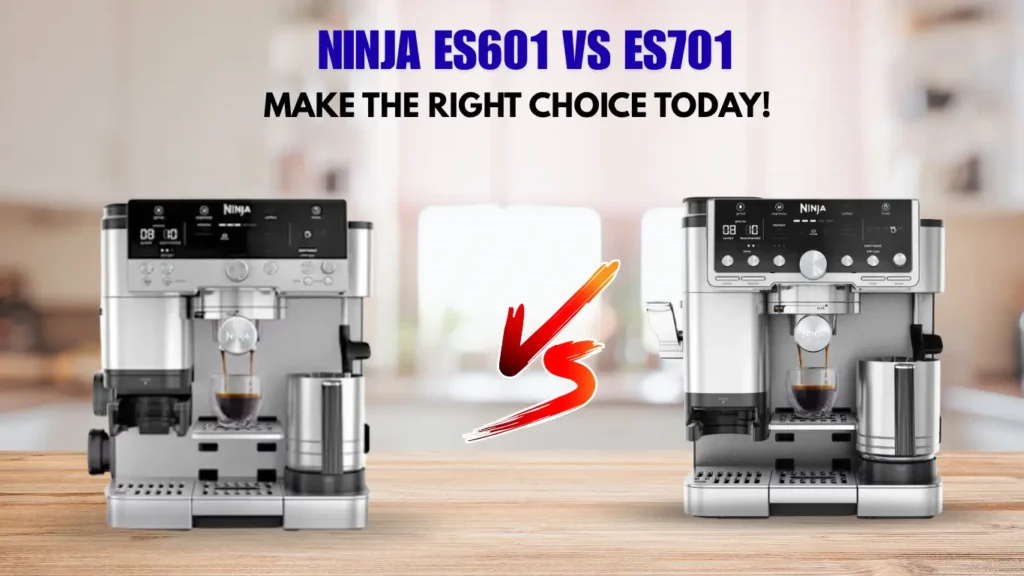Are you torn between brewing coffee with a moka pot or an espresso machine? You’re not alone.
Both methods promise a rich, bold cup, but they deliver very different experiences. Understanding how each works and what they bring to your daily coffee routine can make all the difference. You’ll discover which option suits your taste, lifestyle, and budget best—helping you enjoy every sip just the way you like it.
Keep reading to find out which brewing method will become your new favorite.
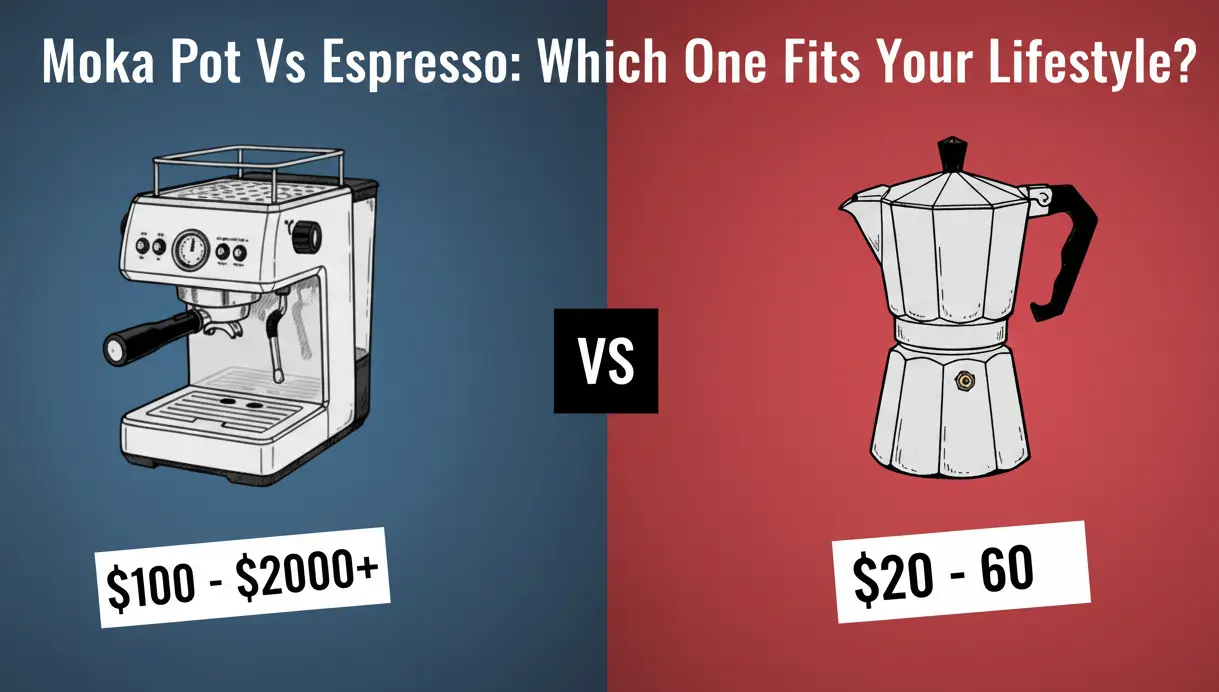
What is Moka Pot
The Moka Pot is a classic Italian coffee maker known for its simplicity and rich coffee aroma. It sits between drip coffee and espresso in strength and taste. Understanding Moka Pot Basics helps compare it clearly to an espresso machine. This section covers its design, brewing process, and flavor profile.
The Moka Pot uses stovetop pressure brewing, creating a unique coffee extraction experience. Many coffee lovers appreciate how it balances ease of use with strong coffee flavor. It’s a popular choice for those seeking an affordable stovetop espresso maker alternative.
Design and Components of a Moka Pot: What Makes It Unique
The Moka Pot has a simple but effective design. It consists of three main parts:
- Bottom Chamber: Holds water before brewing.
- Filter Basket: Holds the coffee grounds.
- Top Chamber: Collects the brewed coffee.
The entire pot is usually made of aluminum or stainless steel. Its compact size makes it easy to use and clean. The bottom chamber heats the water, creating steam pressure. This pressure pushes water through the coffee grounds in the filter basket. The brewed coffee rises into the top chamber.
| Component | Function | Material |
|---|---|---|
| Bottom Chamber | Holds and heats water | Aluminum or Stainless Steel |
| Filter Basket | Holds ground coffee | Metal Mesh |
| Top Chamber | Collects brewed coffee | Aluminum or Stainless Steel |
This design allows the Moka Pot to use stovetop heat and pressure brewing without electricity. It is simple but effective for making strong coffee at home.
How to Brew Coffee in a Moka Pot (Step-by-Step Guide)
The brewing process of a Moka Pot is straightforward. It uses steam pressure to push hot water through coffee grounds. Here is how it works step-by-step:
- Fill the bottom chamber with water up to the safety valve.
- Place medium-fine ground coffee in the filter basket.
- Assemble the pot tightly to avoid leaks.
- Put the Moka Pot on low to medium heat on the stovetop.
- Water heats and creates steam pressure.
- Pressure forces water through the coffee grounds.
- Brewed coffee rises into the top chamber.
- Remove from heat once you hear a hissing sound.
The brewing takes around 4-6 minutes. The coffee grind size is important; too fine can clog the filter, too coarse leads to weak extraction. The Moka Pot uses less pressure than an espresso machine, about 1.5 bars versus 9 bars for espresso. This means the coffee crema is thinner or absent. The process creates a rich, strong coffee but not a true espresso.
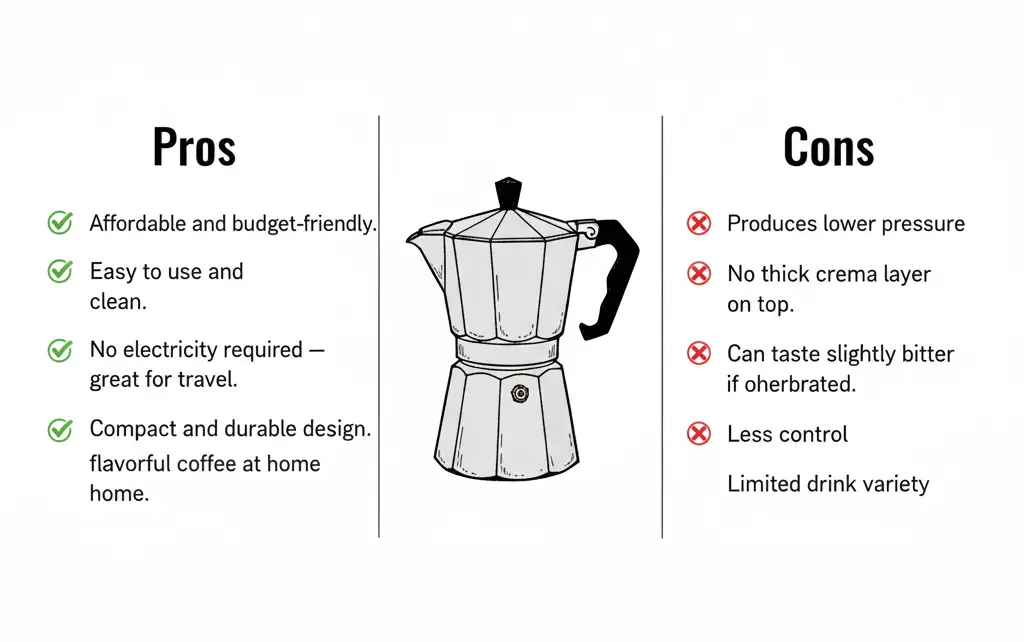
Moka Pot Coffee Flavor Profile
The coffee from a Moka Pot has a distinct flavor profile. It is stronger than drip coffee but lighter than espresso. The coffee aroma is rich with a slightly bitter taste. Some describe it as bold and full-bodied.
- Richness: Good coffee extraction creates a strong, intense flavor.
- Bitterness: Slightly higher due to pressure brewing and heat.
- Acidity: Moderate, less sharp than drip coffee.
- Crema: Usually absent or very thin compared to espresso.
This stovetop espresso maker delivers a coffee flavor comparison that suits those who want strong coffee without an espresso machine. The coffee is robust but not as concentrated. It works well for daily coffee lovers who enjoy Italian coffee maker tradition. The flavor pairs perfectly with milk or sugar for a café-style experience at home.
Espresso Essentials
Espresso Essentials form the foundation of understanding the differences between a Moka Pot and an espresso machine. Both methods produce strong coffee, but they do so in very different ways. Knowing the basics of espresso helps clarify why espresso machines stand out for certain coffee lovers. This section breaks down key aspects such as machine types, how espresso is extracted, and what flavors to expect. The goal is to provide clear, simple explanations to guide your coffee choice.
Different Types of Espresso Machines
Espresso machines come in various styles, each offering a unique brewing experience. They all use pressure to force hot water through finely ground coffee. Here are the main types:
- Manual Espresso Machines: Require user skill to control pressure and timing. Ideal for enthusiasts who enjoy hands-on brewing.
- Semi-Automatic Machines: Use an electric pump but let the user start and stop the shot. They balance control and convenience.
- Automatic Machines: Automatically control water flow and shot time for consistent espresso with less effort.
- Super-Automatic Machines: Grind, tamp, brew, and often milk the coffee automatically. Best for fast, easy espresso.
Here is a quick comparison table for clarity:
| Machine Type | User Control | Ease of Use | Price Range |
|---|---|---|---|
| Manual | High | Low | Moderate to High |
| Semi-Automatic | Medium | Medium | Moderate |
| Automatic | Low | High | Moderate to High |
| Super-Automatic | Very Low | Very High | High |
Each machine type suits different needs. Beginners may prefer automatic machines for ease. Experts might choose manual or semi-automatic for control.
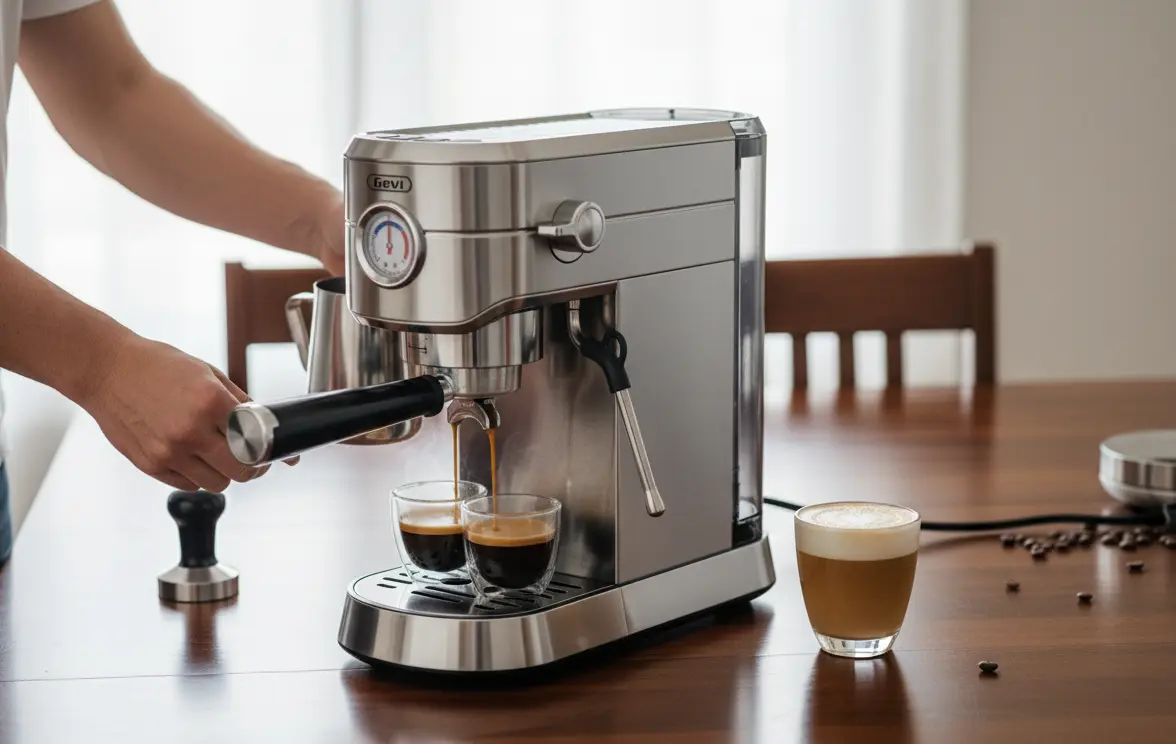
Espresso Extraction Explained: How Pressure Creates Rich Flavor
Espresso extraction is a precise process. It uses high pressure to push hot water through finely ground coffee. This method takes about 25 to 30 seconds.
The pressure is usually around 9 bars. This pressure is key to producing espresso’s thick, creamy layer called the crema. The crema adds aroma and texture.
Steps in the extraction process:
- Grinding: Coffee must be ground very fine for proper extraction.
- Tamping: The grounds are packed firmly in the portafilter to create resistance.
- Brewing: Hot water at about 90-96°C is forced through the coffee at high pressure.
- Extraction Time: Ideally 25-30 seconds for balanced flavor.
Compared to other coffee methods like drip or French press, espresso uses much higher pressure and finer grounds. This creates a more concentrated coffee.
Here is a simple comparison of espresso extraction versus Moka Pot:
| Aspect | Espresso | Moka Pot |
|---|---|---|
| Pressure | ~9 bars | 1-2 bars (steam pressure) |
| Grind Size | Fine | Medium-fine |
| Brewing Time | 25-30 seconds | 3-5 minutes |
| Water Temperature | 90-96°C | Boiling point (~100°C) |
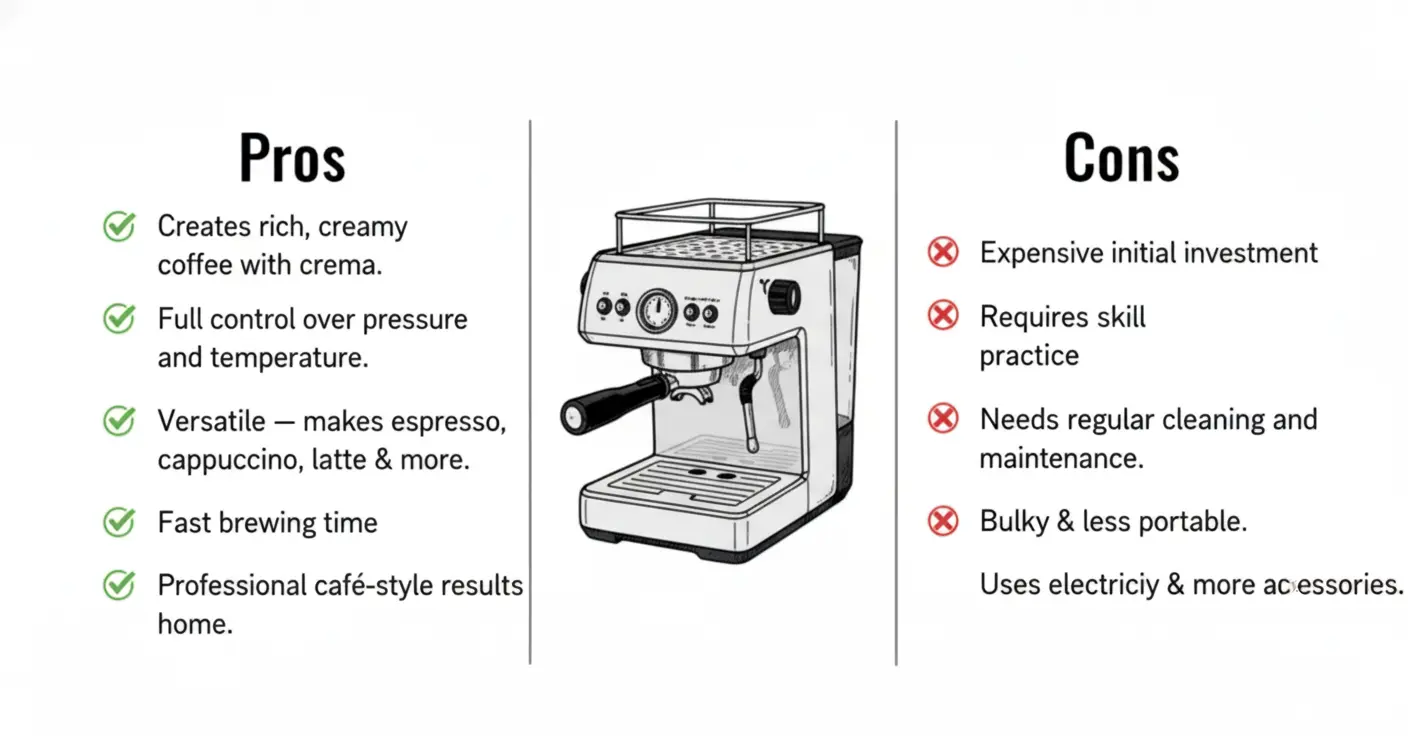
Taste Profile: What Makes It Bold, Creamy, and Balanced
Espresso delivers a bold, intense flavor that many coffee lovers enjoy. The high pressure extracts oils and solids that give espresso its thick body.
Key taste features of espresso include:
- Rich and concentrated: Much stronger than regular coffee.
- Complex flavors: Notes can include chocolate, caramel, fruit, or nuts.
- Balanced bitterness and sweetness: Neither taste overpowers the other.
- Velvety texture: The crema adds a smooth mouthfeel.
Espresso’s flavor depends on the coffee beans, roast level, and extraction quality. Fresh beans and proper technique matter a lot.
In contrast, Moka Pot coffee is strong but less refined. It often tastes a little more bitter and lacks the crema layer.
Here is a brief flavor comparison:
| Feature | Espresso | Moka Pot |
|---|---|---|
| Strength | Very strong and concentrated | Strong but lighter than espresso |
| Texture | Thick, creamy with crema | Thin, more watery |
| Bitterness | Balanced bitterness | Often more bitter |
| Flavor Complexity | High complexity | Moderate complexity |
Moka Pot vs Espresso: Brewing Technique Comparison
The Moka pot and espresso machine are popular tools for making strong coffee. Both create rich flavors but use very different brewing methods. Understanding their brewing techniques helps coffee lovers choose the right tool for their taste and routine. Comparing how these devices work shows why the coffee they produce varies in taste, texture, and strength.
Pressure Differences Between Moka Pot and Espresso Machines
Pressure plays a key role in brewing coffee. Espresso machines use high pressure to force hot water through finely ground coffee. This process extracts oils and flavors quickly, creating a dense, creamy coffee called espresso.
- Espresso machines generate around 9 bars (130 psi) of pressure.
- This high pressure extracts more flavor and crema, the creamy layer on top of espresso.
The Moka pot works differently. It uses steam pressure created by boiling water in a sealed chamber. This pressure pushes water up through the coffee grounds into the upper chamber.
- Moka pots produce about 1.5 bars (22 psi) of pressure.
- Lower pressure results in a strong but less creamy coffee compared to espresso.
| Brewing Method | Pressure Level | Resulting Coffee |
|---|---|---|
| Espresso Machine | ~9 bars (130 psi) | Rich, creamy espresso with crema |
| Moka Pot | ~1.5 bars (22 psi) | Strong, bold coffee without crema |
The pressure difference explains the texture and flavor contrast between moka pot coffee and espresso.
Heat Source Comparison
Heat source impacts how coffee brews and tastes. Both moka pots and espresso machines need heat to extract flavors, but they use it differently.
- Moka pots sit directly on a stove or gas burner. The bottom chamber heats water until it boils and creates steam pressure.
- The heat is indirect but constant, rising through the coffee grounds slowly.
- Espresso machines have built-in electric heating elements. These maintain precise water temperature and pressure during extraction.
This control helps espresso machines keep temperature stable between 88°C and 95°C (190°F to 203°F). This range extracts balanced flavors without burning coffee.
Moka pots depend on stove heat, which can be less consistent. Users must watch the flame or heat level to avoid overheating or under-extracting coffee.
| Device | Heat Source | Temperature Control |
|---|---|---|
| Moka Pot | Stove or gas burner | Manual, less precise |
| Espresso Machine | Electric heating element | Automatic, precise |
Heat source differences affect brewing consistency and flavor clarity between the two methods.
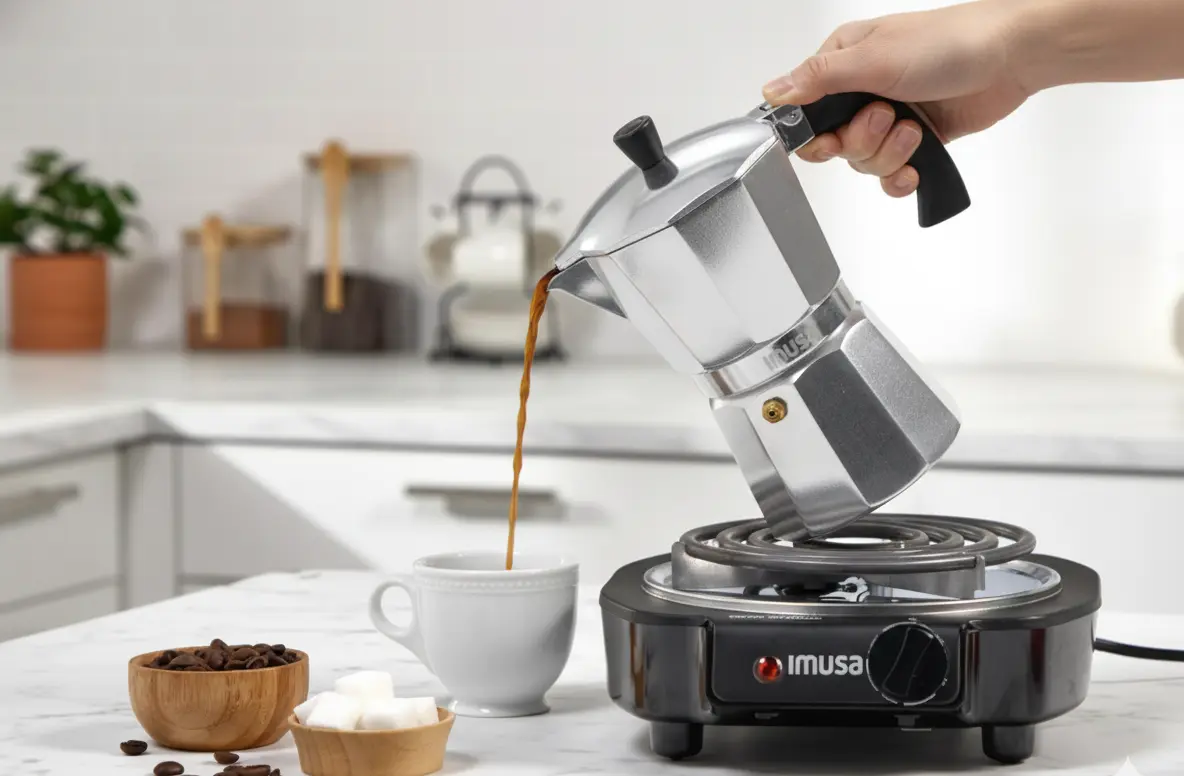
Brew Time Differences
Brew time influences coffee taste and strength. Espresso machines are designed for speed. They extract coffee in about 25 to 30 seconds.
- High pressure pushes water quickly through coffee grounds.
- Short brew time prevents over-extraction and bitterness.
Moka pots take longer. Brewing usually lasts 4 to 5 minutes.
- Water heats slowly, building steam pressure gradually.
- Longer contact time with coffee grounds extracts more solids.
- Can result in a stronger, sometimes more bitter cup.
Here is a quick comparison:
| Method | Approximate Brew Time | Flavor Impact |
|---|---|---|
| Espresso Machine | 25-30 seconds | Bright, balanced, less bitter |
| Moka Pot | 4-5 minutes | Stronger, bolder, sometimes bitter |
Brew time shapes how each method extracts coffee flavors and affects the final taste.
Taste and Texture: Moka Pot vs Espresso Coffee Flavor Comparison
The taste and texture differences between a Moka pot and espresso are striking. Both brewing methods produce strong coffee but deliver distinct experiences. Understanding these differences helps coffee lovers choose the best method for their preferences. The Moka pot offers a rich, bold cup with a unique texture, while espresso provides an intense, smooth shot with specific crema and aroma characteristics. Exploring body, mouthfeel, crema, and flavor notes reveals how each method shapes the coffee’s personality.
Body And Mouthfeel
The body and mouthfeel of coffee describe how heavy or light the liquid feels on the palate and its texture. Moka pot coffee tends to have a medium to full body. It feels thicker than drip coffee but lighter than espresso. This happens because the Moka pot uses steam pressure, which is lower than espresso machines, extracting less oil and fine particles.
Espresso has a full body and a creamy, velvety mouthfeel. The high pressure forces more coffee oils and fine particles into the cup, creating a dense texture that coats the tongue.
| Aspect | Moka Pot | Espresso |
|---|---|---|
| Pressure | 1-2 bars (steam pressure) | 9 bars (pump pressure) |
| Body | Medium to full | Full and rich |
| Mouthfeel | Thick but slightly coarse | Velvety and smooth |
In simple terms:
- Moka pot coffee feels heavier than drip but lighter than espresso.
- Espresso feels dense and creamy, almost like a coffee dessert.
People who enjoy a rich cup with some texture might prefer Moka pot coffee. Those who want a smooth, intense experience lean toward espresso.
Crema Presence
Crema is the foamy, golden layer on top of espresso. It forms because of high pressure during brewing, which emulsifies coffee oils and traps carbon dioxide. This layer adds to espresso’s texture and aroma.
Moka pot coffee usually lacks crema. The lower pressure and brewing style do not generate enough force to create this foam. Instead, Moka pot coffee has a thin layer of bubbles or light froth that disappears quickly.
Crema affects the drinking experience in several ways:
- Visual appeal: Crema makes espresso look rich and inviting.
- Texture: Adds a creamy, smooth layer on top of the coffee.
- Flavor: Slightly bitter, balancing espresso’s intense taste.
Here is a quick comparison of crema characteristics:
| Feature | Moka Pot | Espresso |
|---|---|---|
| Crema Appearance | None or very thin bubbles | Thick, golden, persistent |
| Crema Impact | Minimal to none | Enhances texture and flavor |
For coffee lovers who enjoy crema’s creamy texture and aroma, espresso is the preferred choice. Moka pot drinkers appreciate a straightforward cup without this layer.
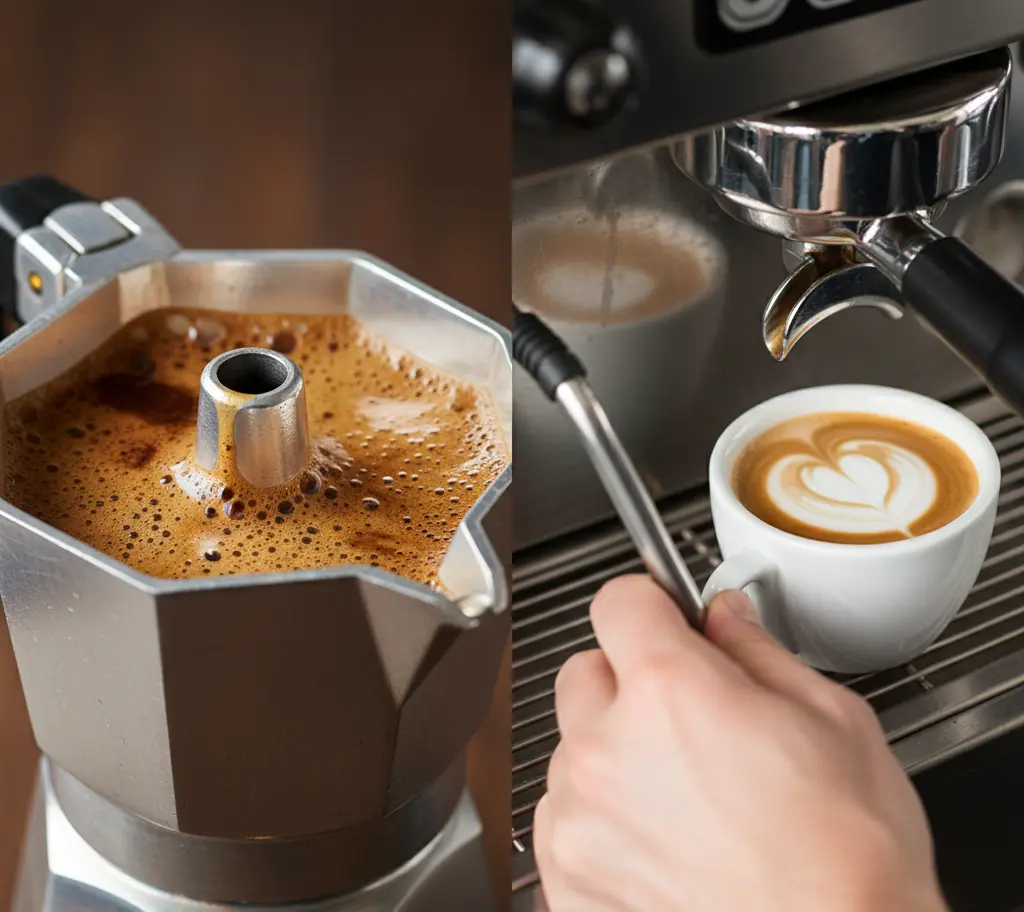
Aroma And Flavor Notes
Aroma and flavor vary greatly between Moka pot and espresso. The brewing process impacts which compounds dissolve and develop in the cup.
Moka pot coffee offers bold, rich aromas with a slightly smoky or caramelized scent. It highlights chocolate and nutty notes, sometimes with a mild fruitiness. The moderate pressure extracts many flavors but misses some volatile oils found in espresso.
Espresso delivers intense, complex aromas that include floral, fruity, and spicy hints. The high pressure extracts more oils and acids, producing a vibrant and sharp flavor profile. Espresso often tastes brighter and more layered than Moka pot coffee.
| Feature | Moka Pot | Espresso |
|---|---|---|
| Aroma | Rich, chocolatey, nutty, smoky | Complex, floral, fruity, spicy |
| Flavor | Bold, sweet, smooth | Bright, intense, layered |
| Acidity | Moderate | Higher, sharp |
Summary of aroma and flavor differences:
- Moka pot coffee feels warm and comforting.
- Espresso offers a lively, punchy taste experience.
The choice depends on whether you want a smooth, mellow cup or a powerful, aromatic shot.
Moka Pot vs Espresso Machine Cost: Equipment, Maintenance, and Value
Choosing between a Moka Pot and an espresso machine involves more than just taste. Equipment and cost play a big role in deciding which one fits your lifestyle and budget. Understanding the initial investment, maintenance needs, and portability of both options helps you make a smart choice. This section breaks down these factors clearly.
Initial Investment
The cost difference between a Moka Pot and an espresso machine can be significant. A Moka Pot is usually very affordable and simple. Espresso machines vary widely in price, from budget models to high-end machines. Here’s a quick comparison:
| Equipment | Typical Price Range | Notes |
|---|---|---|
| Moka Pot | $20 – $60 | Basic design, easy to use |
| Espresso Machine | $100 – $2000+ | Wide range of features and quality |
Moka Pots offer a low entry cost. They are perfect for those on a tight budget. Espresso machines require more money upfront. Higher price often means more control over brewing and better coffee quality.
Other costs to consider:
- Grinder: Essential for espresso machines, adds to cost
- Accessories: Tamper, milk frother, filters for espresso
- Replacement parts: Gaskets and filters for both types
Maintenance Comparison
Maintaining coffee equipment affects long-term costs and ease of use. Moka Pots are simple to clean. They have few parts and no electronics. Usually, rinsing and occasional deep cleaning with vinegar keeps them working well.
Espresso machines require more care. They have pumps, boilers, and electrical parts. Cleaning involves:
- Daily rinsing of portafilter and group head
- Regular descaling to prevent mineral build-up
- Cleaning steam wands and drip trays
Neglecting maintenance can lead to malfunction or bad-tasting coffee. Here’s a summary table of maintenance tasks:
| Task | Moka Pot | Espresso Machine |
|---|---|---|
| Daily Cleaning | Rinse parts, dry | Rinse portafilter, wipe machine |
| Weekly | Check gasket, clean inside | Clean group head, steam wand |
| Monthly | Deep clean with vinegar | Descale, replace filters |
Time and effort for maintenance is higher with espresso machines. Moka Pots suit users who prefer low-maintenance tools.
Portability
Portability matters for those who want coffee on the go or have limited kitchen space. Moka Pots are compact and lightweight. They need only a heat source like a stove. This makes them ideal for travel, camping, or small kitchens.
Espresso machines are bulkier and heavier. Most models require electricity and a stable surface. Some portable espresso makers exist, but they often cost more and require manual pumping.
Here’s a quick portability comparison:
- Moka Pot: Small, no electricity needed, easy to pack
- Espresso Machine: Heavy, needs power, limited travel use
For those who want espresso-style coffee while traveling, a Moka Pot is practical. It delivers strong coffee without the need for complex equipment.
User Experience
The user experience between a Moka Pot and an espresso machine can differ greatly. Both devices brew strong coffee but offer unique processes and challenges. Understanding how each feels to use helps in choosing the right coffee maker for daily use. This section breaks down the key aspects of user experience, focusing on ease of use, cleaning, and skill level required.
Ease of Use: Which Is Simpler—Moka Pot or Espresso Machine?
The Moka Pot is simple and straightforward. You fill the bottom chamber with water, add coffee grounds to the filter basket, and place it on the stove. Within minutes, coffee brews through steam pressure. It has no buttons or settings, making it easy for beginners.
- Simple steps: Fill water, add coffee, heat.
- No electricity needed: Works on any stove.
- Compact design: Easy to store and carry.
The espresso machine requires more attention. Many models have buttons, levers, and pressure controls. You must grind coffee finely and tamp it evenly. The machine forces hot water through the coffee at high pressure. This takes more time to learn and adjust.
| Feature | Moka Pot | Espresso Machine |
|---|---|---|
| Setup | Fill water and coffee, place on stove | Fill water, grind coffee, adjust settings |
| Control | Minimal control | Adjust pressure, temperature, and timing |
| Time | 3-5 minutes | 1-3 minutes |
Cleaning Process: Step-by-Step Maintenance for Each Brewer
Cleaning a Moka Pot is quick and easy. After brewing, disassemble the pot into three parts: the top chamber, filter basket, and bottom chamber. Rinse each part with warm water and avoid soap to keep the metal seasoned. Dry all parts before reassembling.
- No special brushes needed.
- Parts are dishwasher safe in some models but hand washing is best.
- Regular cleaning prevents coffee oils from affecting taste.
Espresso machines need more care. Some parts require daily cleaning, while others need weekly attention. The portafilter, group head, and steam wand collect coffee oils and milk residue. Use brushes and cleaning solutions to keep these clean.
- Remove and rinse portafilter after each use.
- Backflush group head with cleaning tablets weekly.
- Wipe steam wand and purge milk after every use.
| Cleaning Task | Moka Pot | Espresso Machine |
|---|---|---|
| Daily Cleaning | Rinse parts with warm water | Clean portafilter, steam wand, wipe machine |
| Weekly Cleaning | Not required | Backflush group head, deep clean parts |
| Tools Needed | None or soft cloth | Brushes, cleaning tablets, cloth |
Skill Level Required: Beginner vs Expert Brewing Control
The Moka Pot suits beginners and casual coffee drinkers. The process is mostly automatic after adding water and coffee. It requires some attention to heat level to avoid burnt coffee but no special training. Users learn quickly with little trial and error.
- Basic understanding of stove use.
- No grinding precision needed; medium grind works well.
- Low chance of errors affecting taste greatly.
The espresso machine demands higher skill. Users must learn to grind coffee to the correct fineness, tamp evenly, and monitor extraction time. Adjusting temperature and pressure improves flavor but needs practice. Mistakes result in bitter or weak coffee.
- Knowledge of espresso brewing principles helpful.
- Practice needed to perfect tamping and timing.
- Regular calibration of machine settings improves results.
Best Use Cases
Choosing between a Moka pot and an espresso machine depends on how and where you want to enjoy your coffee. Each method suits different needs and places. Understanding the best use cases helps pick the right coffee maker for your lifestyle. Both tools make strong coffee but work differently. The Moka pot brews on a stovetop using steam pressure, while the espresso machine uses higher pressure and temperature. Let’s explore where each shines best.
Home Brewing: Which Coffee Maker Fits Your Kitchen Routine?
At home, simplicity and taste matter most. The Moka pot is great for people who want rich coffee without a complex machine. It fits small kitchens and needs only a stove or heat source. The espresso machine, though, brings café-style drinks to your kitchen. It needs more space and some skill but offers versatile coffee options.
- Moka Pot: Easy to use and clean.
- Espresso Machine: Offers control over grind size and extraction.
- Moka Pot: Affordable and durable.
- Espresso Machine: Can make lattes, cappuccinos, and more.
The following table compares key features for home brewing:
| Feature | Moka Pot | Espresso Machine |
|---|---|---|
| Cost | Low | High |
| Space needed | Small | Large |
| Skill level | Beginner | Intermediate to Expert |
| Drink variety | Limited | Wide |
| Cleaning | Simple | Complex |
For daily coffee lovers with little time, Moka pot works well. Those who enjoy experimenting with espresso-based drinks benefit from the machine.
Cafe Settings: Why Espresso Machines Dominate Professional Use
Cafes need fast, consistent coffee that pleases many customers. Espresso machines dominate here because they deliver high-quality shots quickly. Baristas control extraction pressure and milk frothing to craft various drinks. The Moka pot is rare in cafes due to slower brewing and less consistency.
Espresso machines offer:
- Speed: Serve many customers fast.
- Consistency: Uniform taste every time.
- Versatility: Make espresso, cappuccino, latte, and more.
The Moka pot suits small or specialty cafes focusing on simple brewed coffee. It creates a unique flavor but needs more time for each cup. It also requires manual effort that limits output during busy hours.
Key factors for cafes:
- Espresso Machine: Ideal for high volume and variety.
- Moka Pot: Good for niche coffee experiences.
- Maintenance: Espresso machines need regular cleaning and service.
Cafes aiming to serve many customers fast choose espresso machines. Small cafes or those with a focus on traditional Italian coffee may use Moka pots for authenticity.
Travel and Outdoors: Why the Moka Pot Is Perfect for Coffee on the Go
Travel and outdoor coffee lovers need portable, easy-to-use gear. The Moka pot fits perfectly here. It is compact, durable, and works on various heat sources like camping stoves or portable burners. No electricity is required. Espresso machines are mostly electric and bulky, making them less practical outside home or cafes.
Moka pot benefits outdoors:
- Lightweight and easy to pack.
- Simple operation without electricity.
- Robust metal design withstands rough use.
Espresso machines for travel usually mean small, battery-powered devices or manual lever machines. These are less common and often pricey. They may not deliver the full espresso experience like larger machines.
Travel coffee options comparison:
| Aspect | Moka Pot | Espresso Machine |
|---|---|---|
| Portability | High | Low to Medium |
| Power source | No electricity needed | Electric or battery |
| Durability | High | Fragile parts |
| Ease of use | Simple | Complex |
Outdoor enthusiasts prefer the Moka pot for its reliability and ease. Espresso machines serve better in controlled environments.
Final Verdict: Moka Pot vs Espresso — Which Should You Choose?
Choosing between a moka pot and an espresso maker depends on your taste. Moka pots brew strong coffee with a rich flavor but less pressure. Espresso machines use high pressure to create thick, creamy shots. Both make great coffee but in different ways.
Consider your budget, space, and how you like your coffee. Either way, you can enjoy fresh coffee at home. Try both and see which fits your style best. Simple, tasty coffee is always a good choice.
FAQs: Common Questions About Moka Pot vs Espresso
What Is The Main Difference Between Moka Pot And Espresso?
Moka Pot uses stovetop steam pressure, while espresso relies on high machine pressure. This creates different textures and aromas.
Is Moka Pot coffee stronger than espresso?
Moka Pot coffee is bold but not as concentrated as espresso. Espresso packs more caffeine and crema.
Can Moka Pot Coffee Taste Like Espresso?
Moka Pot coffee is similar but less intense and creamy than true espresso.
Is It Easier To Use A Moka Pot Or An Espresso Machine?
Moka Pots are simpler to use and clean compared to espresso machines.
Which Is More Affordable, Moka Pot Or Espresso Machine?
Moka Pots cost less and need no electricity, unlike expensive espresso machines.

Hi, I’m Joshua Miller, a U.S.-based food lover, review writer, and Co-founder of KitchenWink.com. I hold a Bachelor of Science in Food Science and Culinary Technology, and for over five years I’ve been testing kitchen gadgets like air fryers, blenders, and other cooking tools.
I’m also a home cook, so every product I review is tried in real kitchens—not just in theory. My reviews are based on real results, simple fixes, and tips that anyone can use. With both formal training and hands-on testing, I make sure my advice is clear, honest, and practical.
My goal is simple: to help home cooks choose the right tools and make cooking easier every day.

